
The Armstrong Whitworth A.W.38 Whitley was one of three British twin-engined, front line bomber types that were in service with the Royal Air Force (RAF) at the outbreak of the Second World War. Alongside the Vickers Wellington and the Handley Page Hampden, the Whitley was developed during the mid-1930s according to Air Ministry Specification B.3/34, which it was subsequently selected to meet. In 1937, the Whitley formally entered into RAF squadron service; it was the first of the three medium bombers to be introduced.

The Blackburn Shark was a British carrier-borne torpedo bomber built by the Blackburn Aircraft company in England. It first flew on 24 August 1933 and went into service with the Fleet Air Arm, Royal Canadian Air Force, Portuguese Navy, and the British Air Observers' School, but was already obsolescent by 1937 and in the following year, replacement by the Fairey Swordfish began.

The Fairey Hendon was a British monoplane, heavy bomber of the Royal Air Force, designed by Fairey Aviation in the late 1920s. The aircraft served in small numbers with one Squadron of the RAF between 1936 and 1939. It was the first all-metal low-wing monoplane to enter service with the RAF.
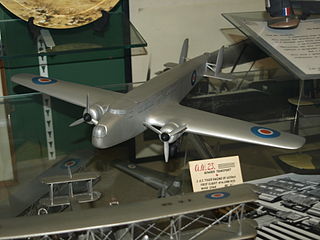
The Armstrong Whitworth A.W.23 was a prototype bomber/transport aircraft produced to specification C.26/31 for the British Air Ministry by Armstrong Whitworth Aircraft. While it was not selected to meet this specification, it did form the basis of the later Armstrong Whitworth Whitley aircraft.
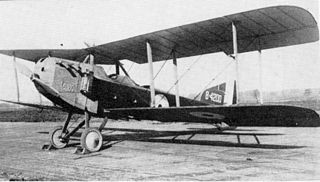
The Armstrong Whitworth F.K.8 was a British two-seat general-purpose biplane built by Armstrong Whitworth during the First World War. The type served alongside the better known R.E.8 until the end of the war, at which point 694 F.K.8s remained on RAF charge.
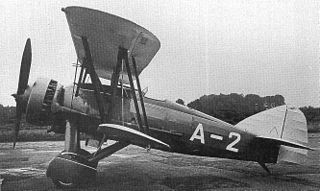
The Armstrong Whitworth A.W.16 was a British single-engine biplane fighter aircraft designed and built by Armstrong Whitworth Aircraft. A number were sold to the Chinese Kwangsi Air Force.
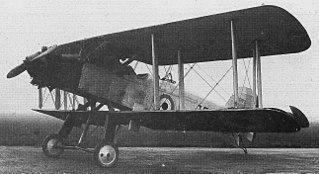
The Armstrong Whitworth Wolf was a British two-seat reconnaissance aircraft ordered by the Royal Air Force in 1923.

The Armstrong Whitworth A.W.14 Starling was a British single-engine biplane fighter developed for the Royal Air Force in the 1920s. The plane was an unsuccessful model, with the Bristol Bulldog being selected instead.

The Blackburn B-3 was a prototype British torpedo bomber designed and built by Blackburn Aircraft as a potential replacement for the Ripon. It was unsuccessful, with only the two prototypes being built.

The Bristol Boarhound was a British army cooperation and liaison aircraft of the 1920s. It was a two-seat biplane with wings of equal span, of steel frame construction with fabric covering.
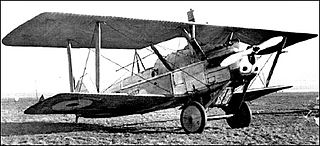
The Vickers Type 94 Venture was a British army cooperation biplane of the 1920s, designed and built by Vickers, as a development of the Vixen. While six were built for the Royal Air Force, they were found unsuitable and were used for experimental work.
The Armstrong Whitworth Armadillo was a British single-seat biplane fighter aircraft built by Armstrong Whitworth.

The Parnall G.4/31 was a 1930s design from the George Parnall and Company to meet Air Ministry Specification G.4/31 for a "general purpose" aircraft.
The Armstrong Whitworth A.W.29 was a British bomber aircraft built by Armstrong Whitworth Aircraft.

The Vickers Type 207 was a single-engined two-seat biplane designed as a shipborne torpedo bomber to an early 1930s specification. Structurally innovative, only one was built.

The de Havilland DH.56 Hyena was a prototype British army cooperation aircraft of the 1920s. A single-engined biplane, the Hyena was designed against an RAF requirement, but was unsuccessful with only two being built, the Armstrong Whitworth Atlas being preferred.

The Vickers Type 253 was a single-engined two-seat biplane general-purpose military machine built to a 1930 government specification. It won a production contract, but this was transferred to the same company's monoplane equivalent, the Wellesley. Only one Type 253 was built.
The Armstrong Whitworth F.K.5 and F.K.6 were experimental triplanes built as escort fighters by Armstrong Whitworth during the First World War. They carried two gunners in nacelles mounted on the centre wing. One example of each type was built, with no further development or production following.
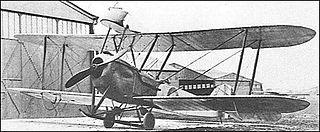
The Vickers F.B.11 was a prototype British three-seat escort fighter of the First World War. A large single-engined biplane, it carried one gunner in a nacelle mounted on the upper wing to give an allround field of fire. Only a single example was completed.
The Westland PV.7 was a private venture submission to a 1930s British specification for a general-purpose military aircraft with two crew. It was a single-engined, high-wing monoplane of promise, but was destroyed early in official tests.
















